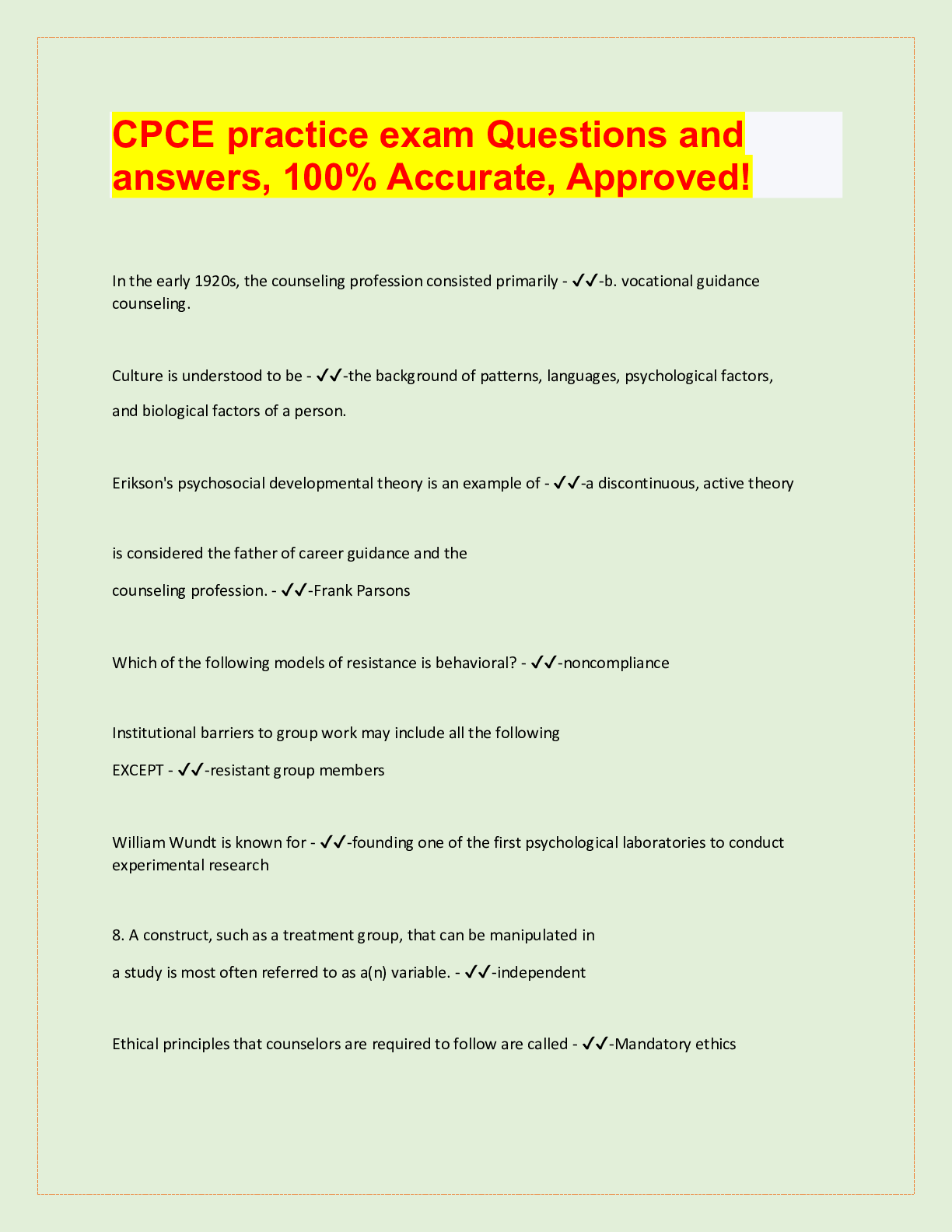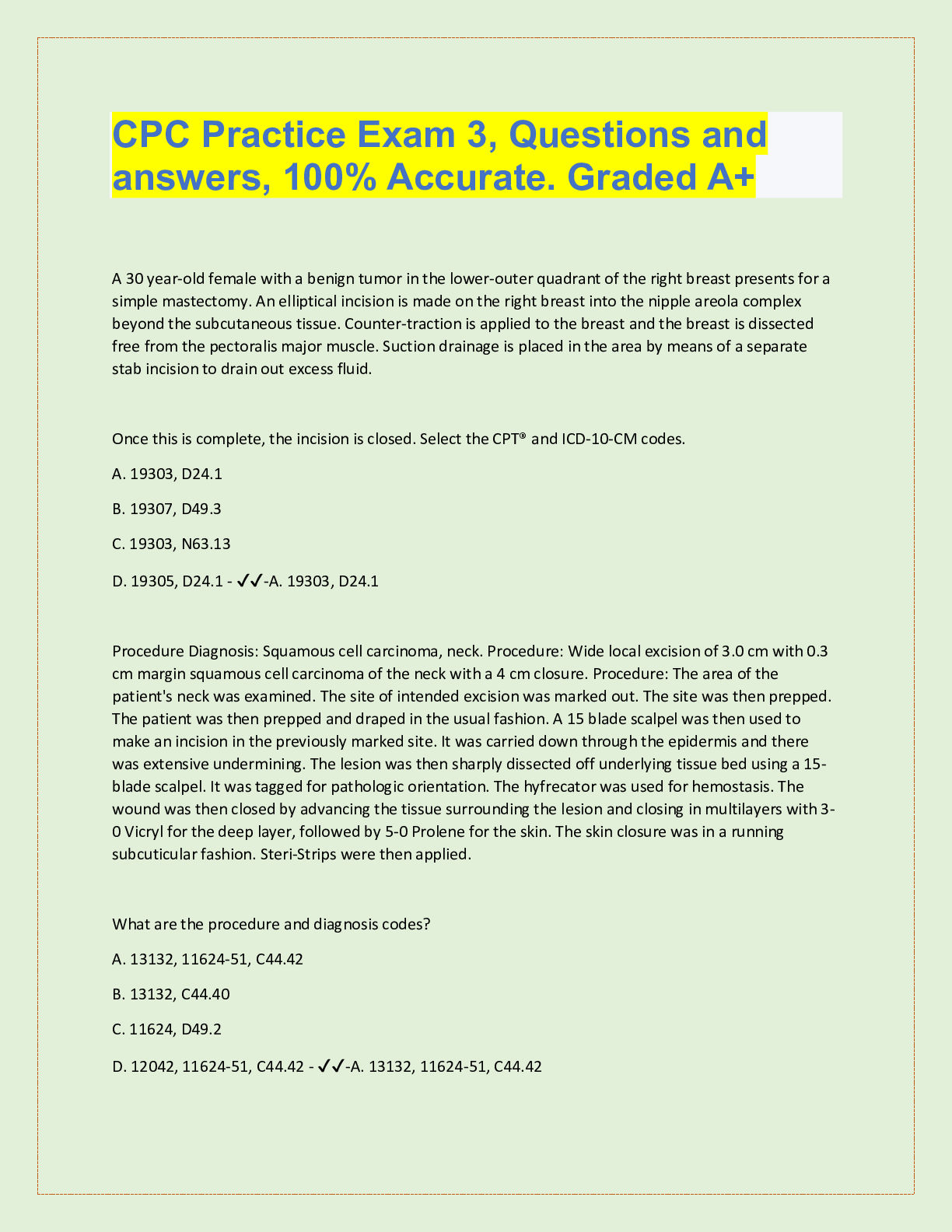*NURSING > QUESTIONS & ANSWERS > Chapter 19--Critical Care (All)
Chapter 19--Critical Care
Document Content and Description Below
Chapter 19--Critical Care MULTIPLE CHOICE 1. The nurse determines that a client’s cardiac output is normal. Which of the following values would be considered normal? 1. 1 L/min. 2. 3 L/min... . 3. 6 L/min. 4. 15 L/min. PTS: 1 DIF: Analyze REF: Cardiac Output 2. A client’s cardiac index is calculated to be 3.1 L/minute/m2. Which of the following could explain this client’s cardiac index value? 1. Acute myocardial infarction 2. Cardiogenic shock 3. This is a normal value 4. Fever PTS: 1 DIF: Analyze REF: Cardiac Output 3. A client with an elevated cardiac index has received diuretic medication as prescribed. The nurse realizes that this medication will affect which cardiac parameter? 1. Afterload 2. Contractility 3. Preload 4. Stroke volume PTS: 1 DIF: Analyze REF: Hemodynamic Monitoring: Preload 4. The nurse is caring for a client who is experiencing an increase in cardiac contractility. Which of the following will decrease contractility and reduce myocardial oxygen demand for this client? 1. Administer Primacor as prescribed. 2. Administer Digoxin as prescribed. 3. Administer beta-blocker as prescribed. 4. Administer potassium chloride as prescribed. PTS: 1 DIF: Analyze REF: Contractility 5. Which of the following interventions would ensure the accuracy of hemodynamic parameters and ensure an air-free system? 1. Slowly flush the system after taking a blood sample. 2. Loosen connections. 3. Keep pressure bag inflated to 300 mmHg. 4. Add extensions to the line. PTS: 1 DIF: Apply REF: Measurement of Hemodynamic Parameters 6. A client is prescribed a vasoactive intravenous medication to maintain a normal blood pressure. Which of the following is not a vasoactive medication? 1. Amiodarone 2. Dopamine hydrochloride 3. Nitroprusside sodium 4. Norepinephrine PTS: 1 DIF: Analyze REF: Intra-Arterial Monitoring: Indications 7. A client’s right atrial pressure is measured as being 6 mmHg. The nurse would document which of the following regarding this client’s pressure? 1. Right arterial pressure within normal limits 2. Right arterial pressure below normal limits 3. Right arterial pressure above normal limits 4. Right arterial pressure unable to obtain PTS: 1 DIF: Apply REF: Pulmonary Artery Parameters 8. A client has an intraparenchymal probe inserted into his brain tissue. The nurse realizes an advantage of this type of intracranial monitoring device would be: 1. low risk of intracerebral bleeding. 2. low risk of infection. 3. sturdy and will not break. 4. an inexpensive method to monitor. PTS: 1 DIF: Analyze REF: Types of Intracranial Pressure Monitoring 9. A client is diagnosed with increased intracranial pressure. Which of the following interventions can be used to reduce this pressure? 1. Administer hypotonic intravenous fluids. 2. Administer Mannitol. 3. Keep head of the bed flat. 4. Keep PaCO2 level above normal. PTS: 1 DIF: Apply REF: Management of Patients with Increased Intracranial Pressure 10. A client who has an endotracheal tube is being considered for a tracheostomy. Which of the following criteria would support the placement of a tracheostomy in this client? 1. Client is unable to maintain airway when extubated. 2. Client has a history of diabetes mellitus. 3. Client has been diagnosed with hypertension. 4. Client is coughing and bucking the endotracheal tube. PTS: 1 DIF: Analyze REF: Tracheostomy 11. A client who is being mechanically ventilated has positive end expiratory pressure set at 20 cm of water. Which of the following should the nurse assess in this client? 1. Hemothorax 2. Pneumothorax 3. Increased venous return 4. Hypertension PTS: 1 DIF: Apply REF: Additional Ventilator Settings and Modes 12. The nurse, planning care for a client who is mechanically ventilated, would plan to administer medication to prevent the onset of which of the following complications? 1. Hyperglycemia 2. Hypertension 3. Stress ulcers 4. Thrombophlebitis PTS: 1 DIF: Apply REF: Stress-Related Mucosal Disease 13. A client who is being mechanically ventilated has been receiving propofol (Diprivan) to enhance compliance. Which of the following will occur when the medication is discontinued and the client is removed from the ventilator? 1. The client will demonstrate hypotension. 2. The nurse will need to administer Narcan. 3. The client will develop a dysrhythmia. 4. The client will quickly gain consciousness. PTS: 1 DIF: Analyze REF: Table 19-7 Medications Commonly Used to Enhance Compliance with Mechanical Ventilation 14. A client has been participating in weaning from the ventilator for several days. Which of the following should be done to assist this client to regain strength? 1. Provide full ventilatory support during the overnight hours. 2. Withdraw medications to enhance compliance with mechanical ventilation. 3. Conduct passive range of motion to all extremities. 4. Assist to a sitting position and dangle legs off the side of the bed. PTS: 1 DIF: Apply REF: Ventilatory Weaning: Indications 15. Which of the following nursing interventions would be appropriate for a client who has had an endotracheal tube removed? 1. Evaluate arterial blood gas analysis 2 hours after extubation. 2. Encourage the client to limit movement for the first day after extubation. 3. Provide oral care immediately after extubation. 4. Instruct the client that hoarseness will be present for at least 3 months. PTS: 1 DIF: Apply REF: Nursing Management MULTIPLE RESPONSE 1. The nurse is preparing the equipment needed for hemodynamic monitoring. Which of the following equipment should be included in preparation for monitoring? (Select all that apply.) 1. Amplifier 2. Flow and pressure system 3. Monitor 4. Pressure bag, fluid flush system, and tubing 5. Transducer 6. Arm board PTS: 1 DIF: Apply REF: Equipment for Hemodynamic Monitoring 2. The nurse is trying to determine the cause of a dampened waveform. Which of the following could cause a dampened waveform. (Select all that apply.) 1. Air bubbles 2. Blood clots 3. Kinks 4. Loose connections 5. Use of shorter tubing 6. Low blood pressure PTS: 1 DIF: Analyze REF: Measurement of Hemodynamic Parameters 3. A client’s pulmonary artery wedge pressure is 1 mmHg. Which of the following health problems can cause this low pressure? (Select all that apply.) 1. Altered left ventricular function 2. Dehydration 3. Elevations in blood volume 4. Hemorrhage 5. Hypovolemia 6. Peripheral edema PTS: 1 DIF: Analyze REF: Pulmonary Artery Pressure Monitoring 4. A client is determined to not be a candidate for intra-aortic balloon pump monitoring. Which of the following client conditions is the balloon pump contraindicated? (Select all that apply.) 1. Aortic insufficiency 2. Gastric ulcers 3. Dissecting abdominal aortic aneurysm 4. Severe peripheral vascular disease 5. Absent femoral pulses 6. Uncontrolled bleeding PTS: 1 DIF: Analyze REF: Cardiac Assist Devices 5. Which of the following interventions would be appropriate for a client who is being mechanically ventilated? (Select all that apply.) 1. Secure artificial airway. 2. Auscultate lungs every 4 hours and as needed. 3. Monitor endotracheal tube cuff pressure once per shift. 4. Provide alternative form of communication. 5. Apply vest and wrist restraints. 6. Monitor arterial blood gas analysis results and adjust ventilator as needed. PTS: 1 DIF: Apply REF: Table 19-4 Nursing Management of Patients Requiring Mechanical Ventilation [Show More]
Last updated: 1 year ago
Preview 1 out of 6 pages
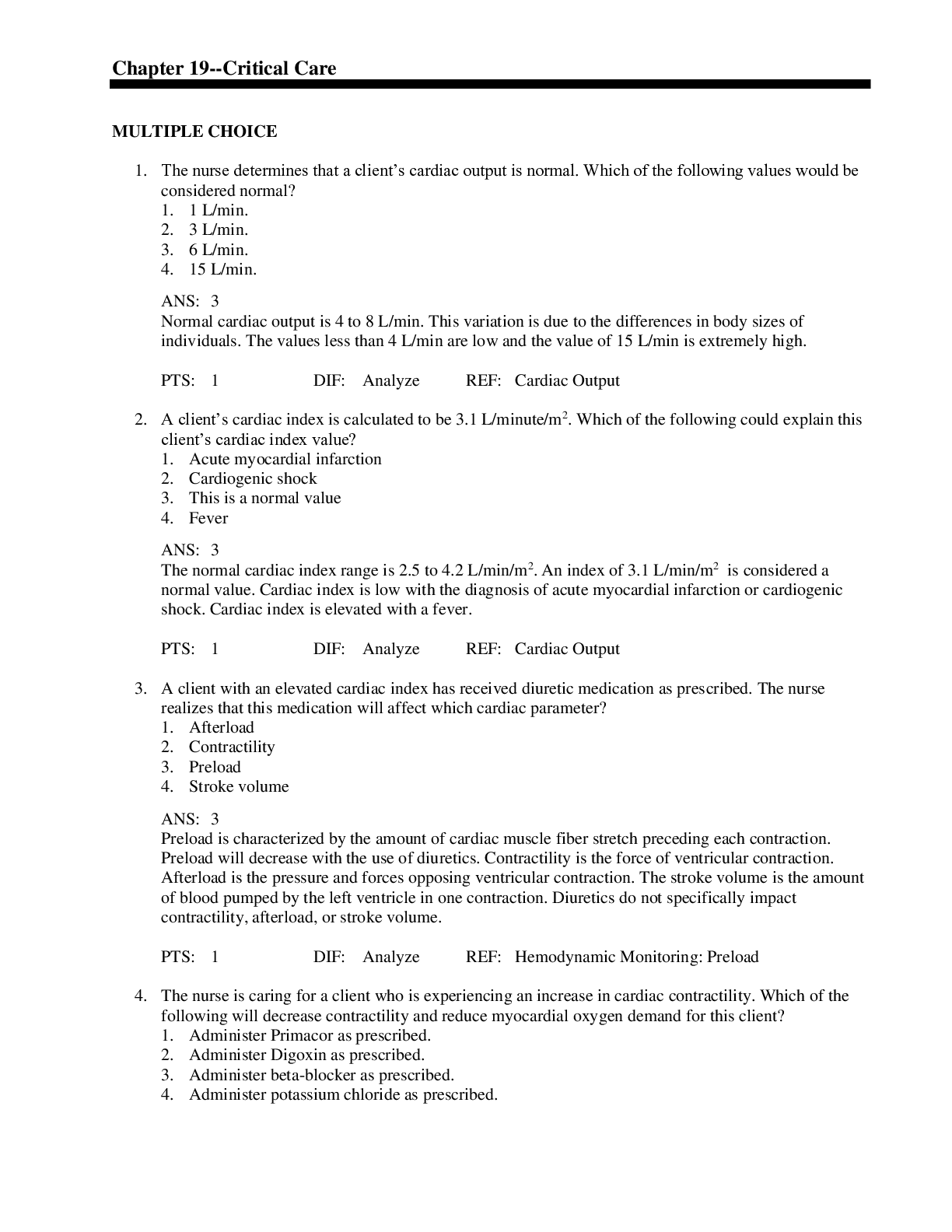
Reviews( 0 )
Document information
Connected school, study & course
About the document
Uploaded On
Jan 28, 2020
Number of pages
6
Written in
Additional information
This document has been written for:
Uploaded
Jan 28, 2020
Downloads
0
Views
33








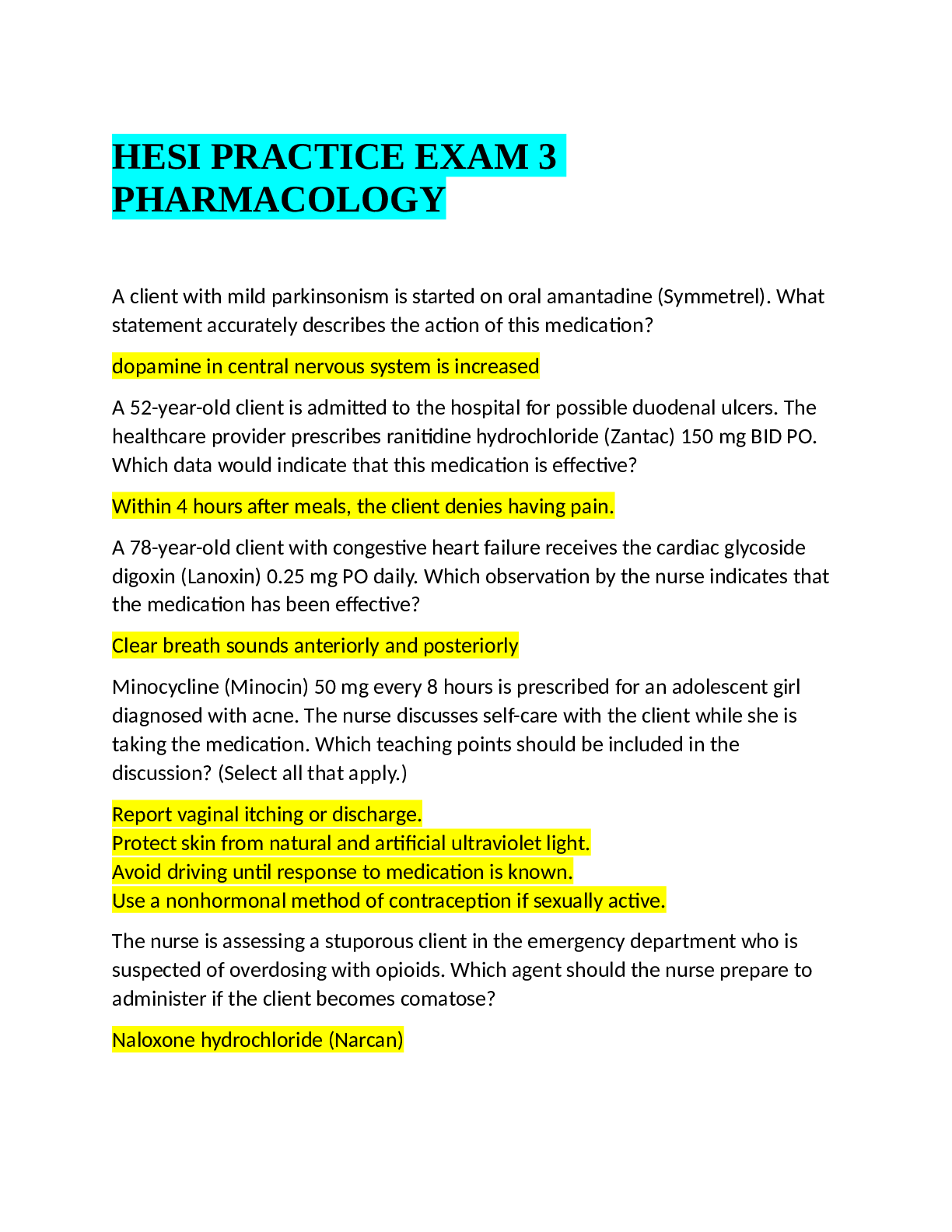




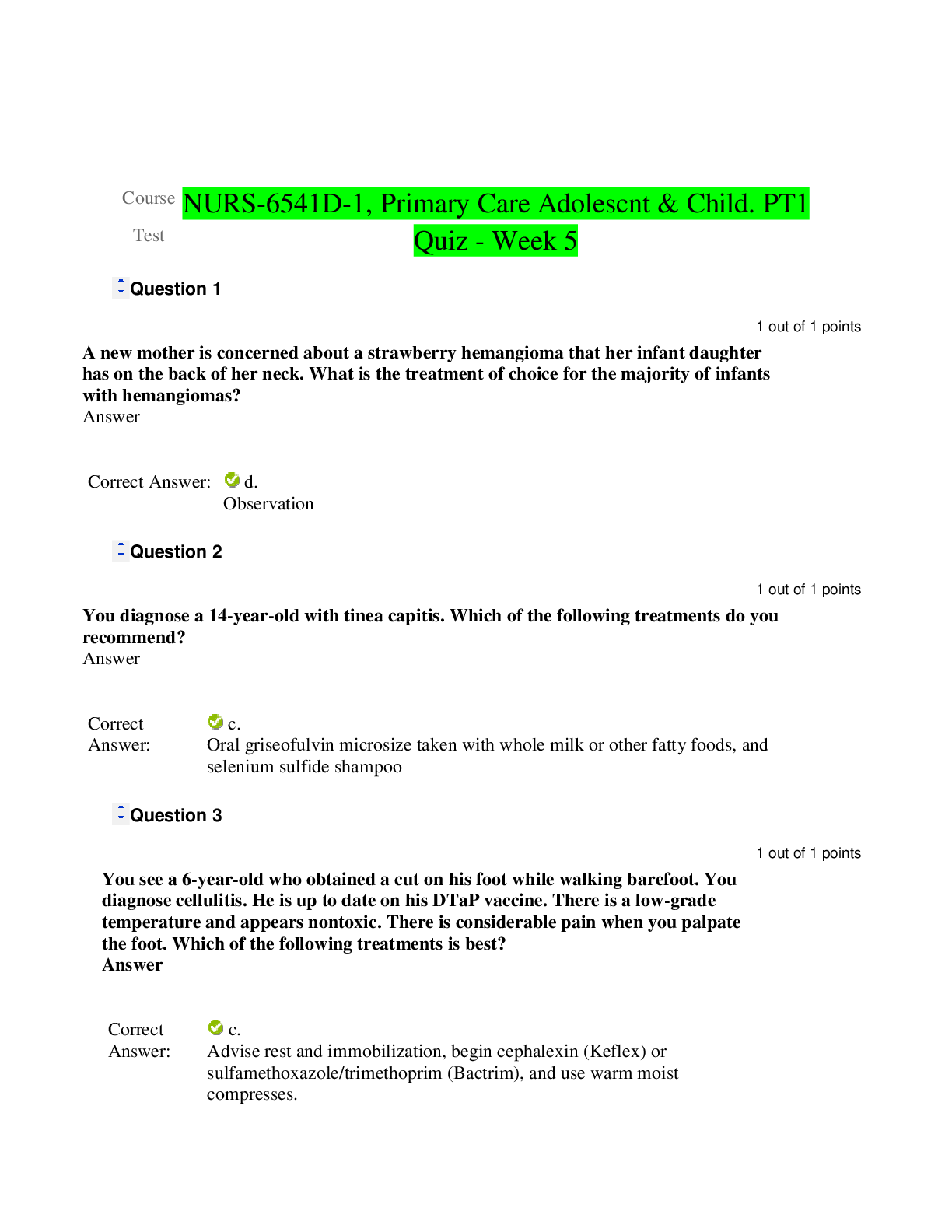
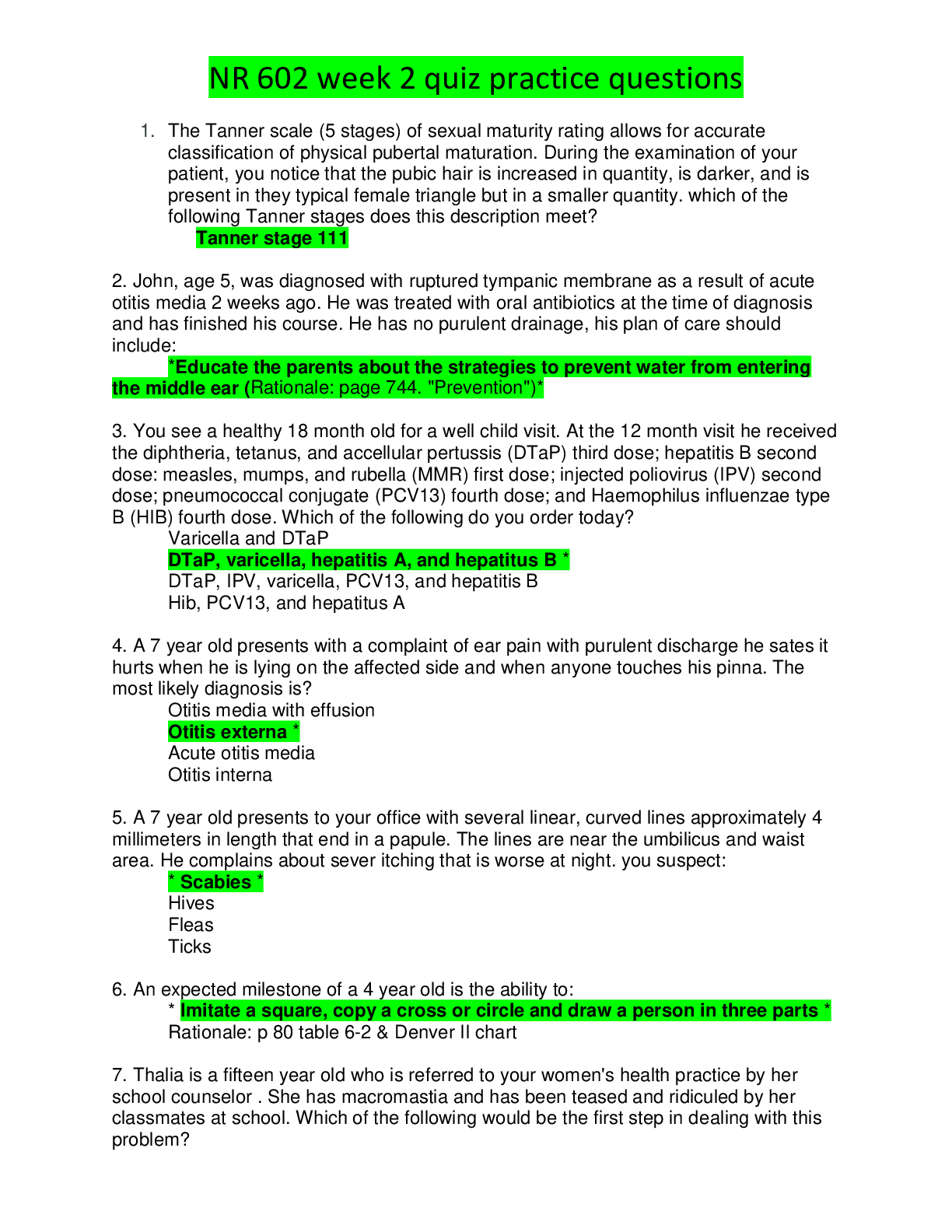
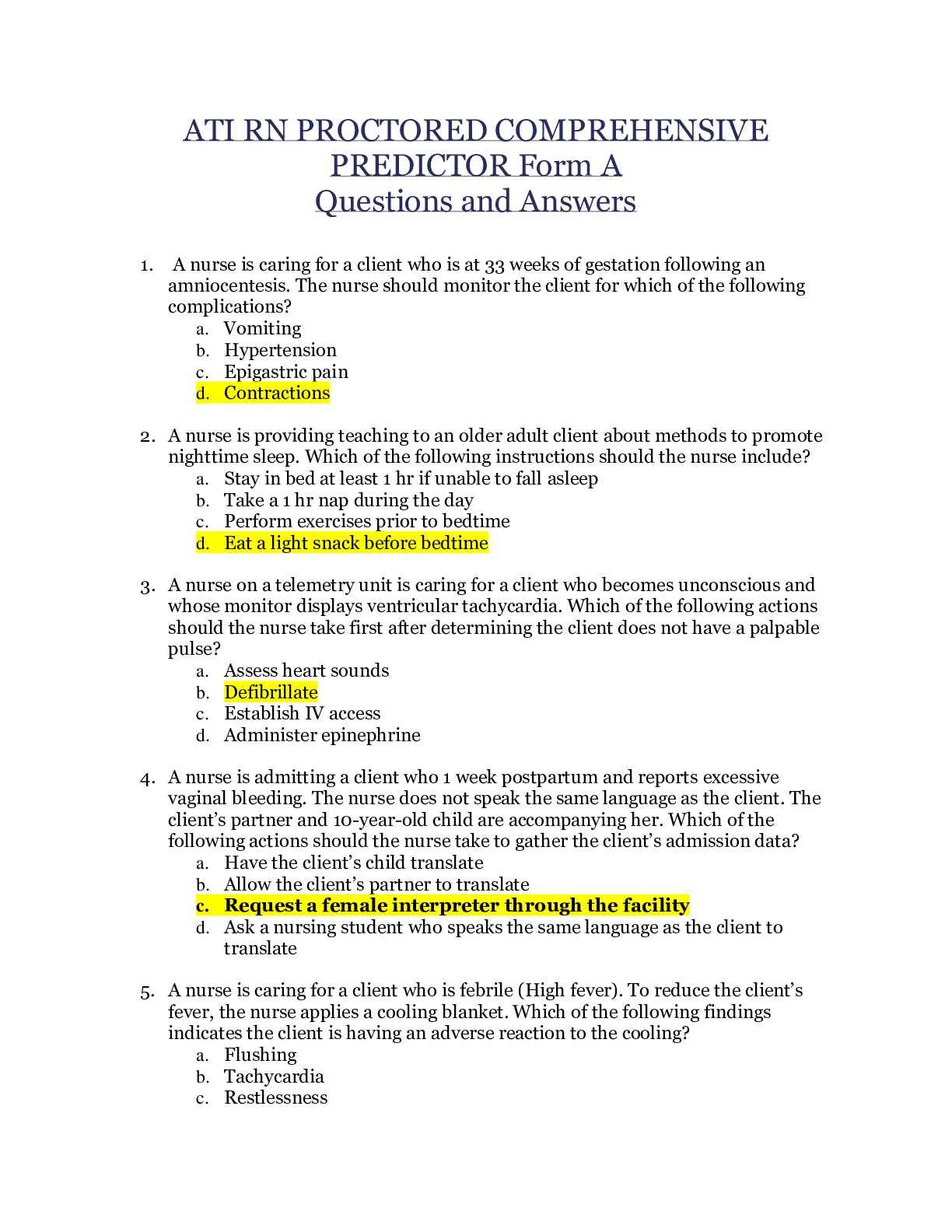
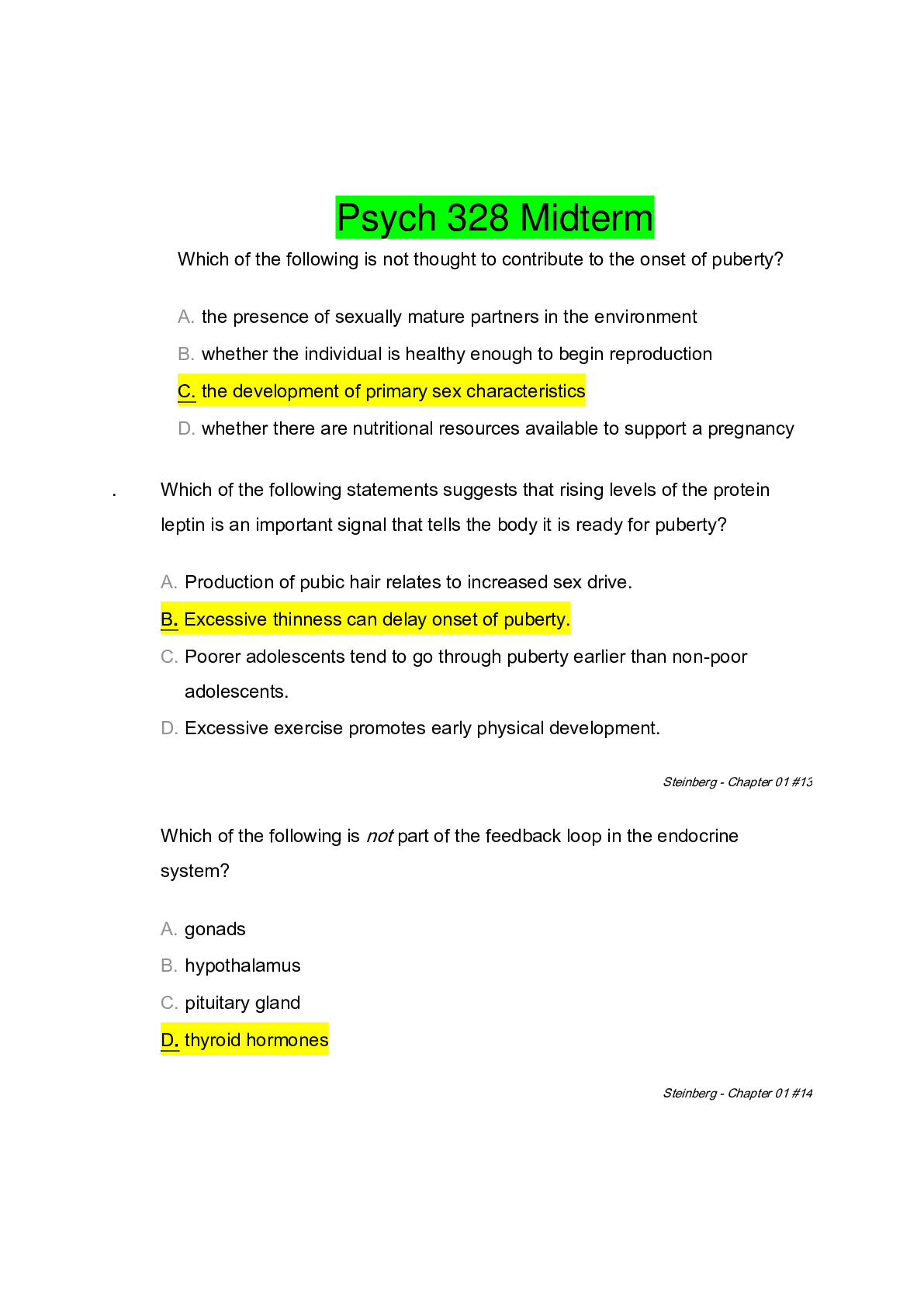
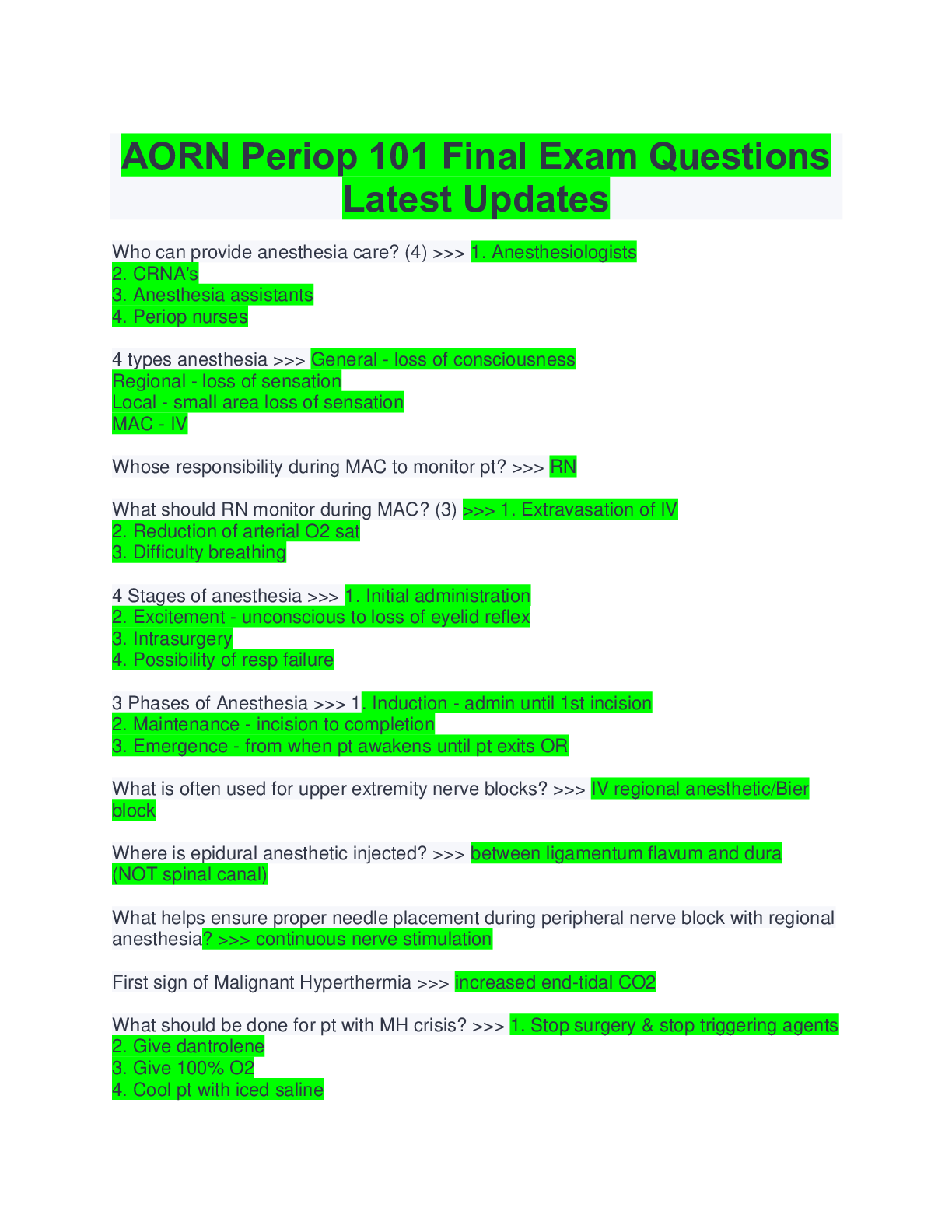










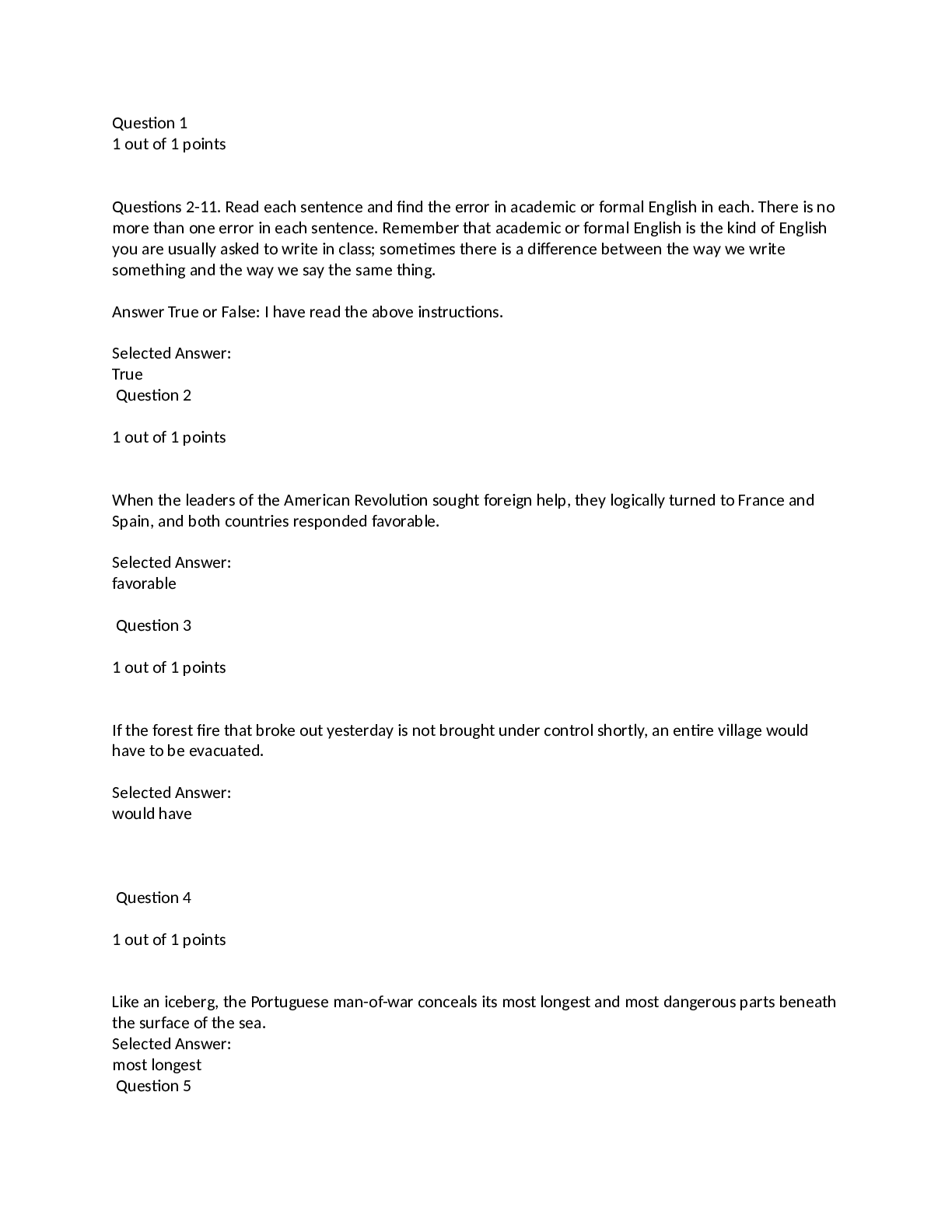
.png)
